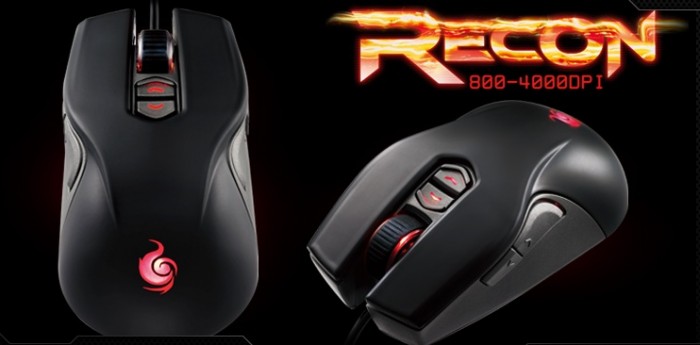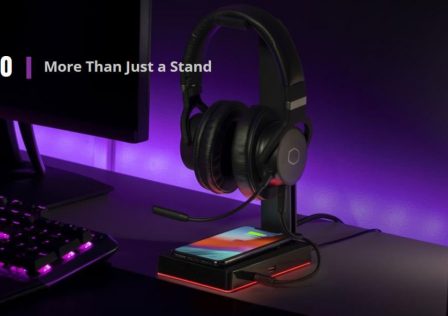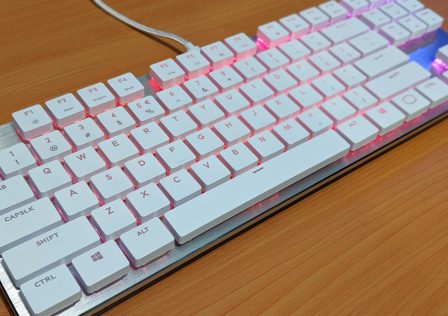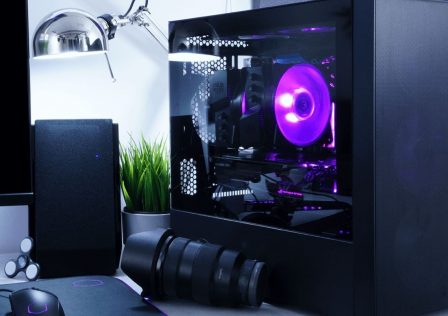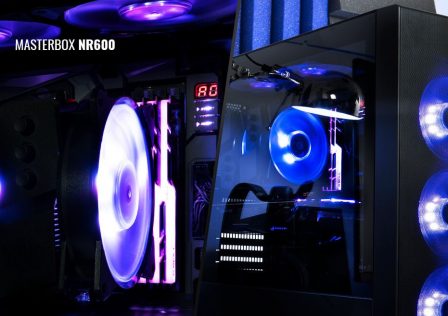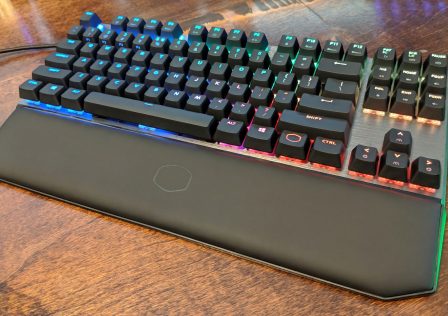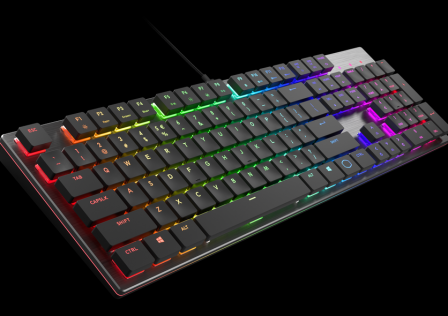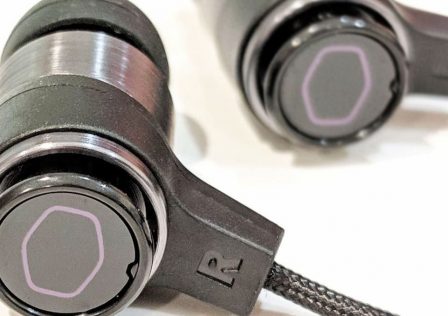Cooler Master has really been on a roll as of late. Just looking at their CM Storm branded peripherals, recently we have looked at the Skorpion mouse bungee, QuickFire Rapid, Trigger, QuickFire Pro, Sentinel Advance II, Speed RX mouse pad, among others. Do you know what they all have in common? They were all impressive products, especially the mice, keyboard, and headset. In a relatively short amount of time, they’ve achieved quite a lot.
Here in front of me is another CM Storm gaming mouse waiting to be tested. This is their latest mouse, the Recon. It’s quite special in the sense that it’s ambidextrous… not many of those around are there? I was a bit worried about the layout of an ambidextrous gaming mouse, so let’s see how the Recon looks and feels.
Unboxing
I’ll tell you from the start, this will be a longer than usual Unboxing section. So let’s start from the top; the box design is pretty much the same as the Sentinel Advance II and Inferno. If it ain’t broke, don’t fix it, right? It’s descriptive and appealing.
Ah, the specs are on the back. Less typing for me! I’ll describe them a bit… the Avago 3090 sensor is the same optical sensor used on the CM Storm Spawn, one of the only CM Storm mice I’ve never used. This explains the identical DPI (dots per inch) ratings. It looks like you can crank up acceleration quite a bit, for the few who would do such a thing. Highest grade Japanese electronic components (micro switches) is a nice thing to have, as is integrated memory and full speed 1000 hz polling rate/1 ms response time. The dimensions indicate it is more or less an average sized mouse.
Opening the box reveals the mouse, covered in clear protective plastic, as well as a photographic features list.
Let me zoom in on that for you.
Multi-color LED is nice to have, it’s something that Cooler Master has spoiled me with since their very first mouse, the Sentinel Advance. But this one packs a bit of a surprise on this regard… as you’ll see later. “Super grip coating” is correct, I’m typing this with only my left hand since my right one is still stuck to the Recon.
So that pretty much wraps up the unboxing. It’s complete with a manual and wrapped cable with a covered USB plug. Nothing to complain about here, it’s a well packaged mouse.
Closer Look
The CM Storm Recon is an ambidextrous mouse designed for the palm grip, but it works as a fingertip grip mouse too. See the following pictures to help you clarify which grip type you use or prefer.
It is an averaged size mouse, a bit smaller than their Sentinel palm grip mouse, and much thinner than the Inferno which works as both a claw grip and palm grip mouse. The shape is pretty straight forward; there isn’t a defined thumbrest on either side and the left and right main buttons are integrated into the body of the mouse. The Recon has 9 programmable buttons.
If you saw our CM Storm Skorpion review, you’ll recognize this shot.
The Recon has three separate LEDs; one behind the scroll wheel, one behind the DPI-cycling buttons, and one under the CM Storm logo. By default, these are all red, but they can each be changed to their own color. Again, the Recon has a surprise in this regard and I’ll elaborate on it later. Note that taking these shots is tricky on my camera, the LEDs are all on the brightest setting, and it’s VERY bright. Brighter than any mouse I’ve seen, in fact. The pictures won’t do it justice.
Red showed up well, and so does green.
Blue looks great.
Lighter blue, it looks much different than the normal blue in person though.
Yellow has a bit more of a green hue than I’d like, but this is unavoidable when you want to allow so many color options.
My personal choice is red, white, and blue.
Note that these are just several color options, the mouse has much more. They give you the whole color spectrum to choose from, but that’s for the next page. On an interesting note, the default profile has a different LED color for each DPI setting; 800 DPI has no LED, 1600 has a red LED, 3200 has a green LED, and 4000 has a blue LED. Sadly I haven’t been able to make other profiles have this function.
Overall I’m pleased with the construction and feel of the Recon. It feels like a good palm grip mouse for averaged size hands, those with larger hands should opt for the Sentinel Advance II. This mouse is a must-have for left-handed people.
I like the “super-grip coating”, but my main complaint is regarding the two buttons behind the scroll wheel. They don’t have enough feedback, and because they’re stacked on top of each other, I have to ungrip the mouse and click them with the point of my finger, otherwise I tend to press both buttons at the same time. They should be positioned side-by-side, like on other CM Storm mice. All of the other buttons have excellent feedback however. I also missed the sleeved cable, but whatever, the Recon’s cable is still protective and gets the job done. Moving on.
Software
The CM Storm Recon has optional software. It’s not needed to use the mouse or even cycle through DPI settings, so like other CM Storm mice, this one is plug-and-play ready. What the software is needed for is customization; you can modify sensor settings, LED settings, button settings, create macro scripts, and manage profiles. The software has been overhauled, and is a bit different than other CM Storm mice, which already had the best mouse software I had seen.
The first tab is the BUTTONS tab. The buttons are defined on the right and shown visually, both of which are very easy to see. You can assign a function to each of the 9 buttons. Below I’ll define each function.
- Default: The default function of the button.
- Mouse Function: This lets you bind any mouse function to any button.
- Keyboard Key: This lets you bind a keyboard function to a mouse button.
- Macro: This lets you bind a macro script to a button.
- Advanced: Lets you choose multimedia, DPI, and profile switching.
- Disable: This disables the selected button. I highly recommend right-handed users disable the 8th and 9th button, and lefties should disable the 6th and 7th button, since they are very easy to click accidentally and are unneeded.
Cooler Master improved upon their already excellent software, by making it less cluttered and adding more LED options, including the whole color spectrum and three separate LEDs. You also no longer have to load the mouse software in order for Acceleration/Response Time/Double Click Speed to change; this was an annoying oversight found on most other CM mice. Very well done, Cooler Master.
Performance
The CM Storm Recon uses the Avago 3090 optical sensor, just like the CM Storm Spawn. This is generally less favorable than a good laser mouse. I happen to have two laser mice on hand to compare it to; the Inferno which uses the Phillips Twin-Eye sensor, and the Sentinel II which uses the Avago 9800 laser sensor, which is the best I’ve ever used. The Avago 3090 and Spawn were very well received, so I still had high expectations for the Recon.
For testing, I just played some games including FPS games demanding of great aim. The games I used include Unreal Tournament 3, Serious Sam 3, Left 4 Dead 2, S.T.A.L.K.E.R. Shadow of Chernobyl, and The Witcher 2. I use slightly lowered OS Sensitivity/acceleration, and 4000 DPI in all of these games.
The mouse sensitivity is pretty much perfect, and anyone should be able to get a perfect feel due to the amount of customization it offers. The sensor is definitely accurate, I have no problems with small movements and precise shots in UT3, in which I tend to use the sniper rifle on every map. 4000 DPI is more than enough for most people, allowing for instant rotations. I am one of few oddballs who actually uses 8200 DPI on the Sentinel Advance II, though.
Lift off distance is average or maybe slightly below, since it’s an optical sensor. No matter what the LOD is set to in the software, the mouse will still track several millimeters above its surface. It’s certainly nothing incredible like the Sentinel Advance II which, with a good mouse bungee like the Skorpion, often has zero movement when listing the mouse off of the mousepad. With 4000 DPI and acceleration customization, you won’t be lifting the mouse off the pad so it isn’t much of an issue.
After gaming for hours with the more demanding palm grip, the light rubber coating on the Recon proved useful. It never gets slippery or anything, just be sure to wipe the mouse off from time to time. This applies to all mice really. I can’t see this coating wearing off, which was an issue with the original Sentinel Advance.
I tested this mouse on the CM Storm Speed RX pad, a cloth type that offers excellent traction. I also had a basic, rough surface pad that has trouble staying flat on my desk. Regardless, the Recon worked fine on both of them, but I highly recommend a good cloth pad like the Speed-RX. It works very well with every laser mouse I’ve used, as well as the Avago 3090 optical sensor on the Recon. I don’t have a rubber composite pad for testing though.
Conclusion
The CM Storm Recon continues Cooler Master’s winning streak. It’s an excellent mouse in every regard; build quality, comfort, customization, performance, and ease of use. It’s one of few ambidextrous mice and it is very comfortable for both left-handed and right-handed users. This is a great choice for casual or serious gamers.
- Appearance: The Recon looks more plain than many other gaming mice, but doesn’t look boring. The matte black finish with grey contrasting sides, and three customizable LEDs really help the Recon excel in this regard. 5/5
- Construction: This mouse is made up of durable plastic, with a “super-grip” light rubber coating which is really perfect. The scroll wheel and buttons all have a great feel except for buttons 4 and 5, located behind the scroll wheel. They have too little feedback and they should be positioned side-by-side, rather than stacked vertically. 4.5/5
- Performance: The sensor isn’t the best I’ve used, but it’s still good. The Recon offers perfect sensitivity thanks to all of the customization, up to 4000 DPI which should be enough for anyone, and you can go as low as 800 DPI. I’d like improved lift-off distance though. 4.5/5
- Functionality: The Recon offers a ton of customization for buttons, sensor, and macro scripts, but it has the most LED options I’ve ever seen. The software has an improved layout and couldn’t be better. I do wish Lift off Distance adjustment was more effective, since it seems to do nothing. The lack of separate X and Y DPI settings might disappoint some. 4.75/5
- Value: The Recon has an MSRP of a little over 40 Euros. This puts it in line with plenty of gaming mice, but it also costs less than many others. It’s a great value. 5/5
- Overall: 95/100
"Quality"
The CM Storm Recon continues Cooler Master's winning streak.

